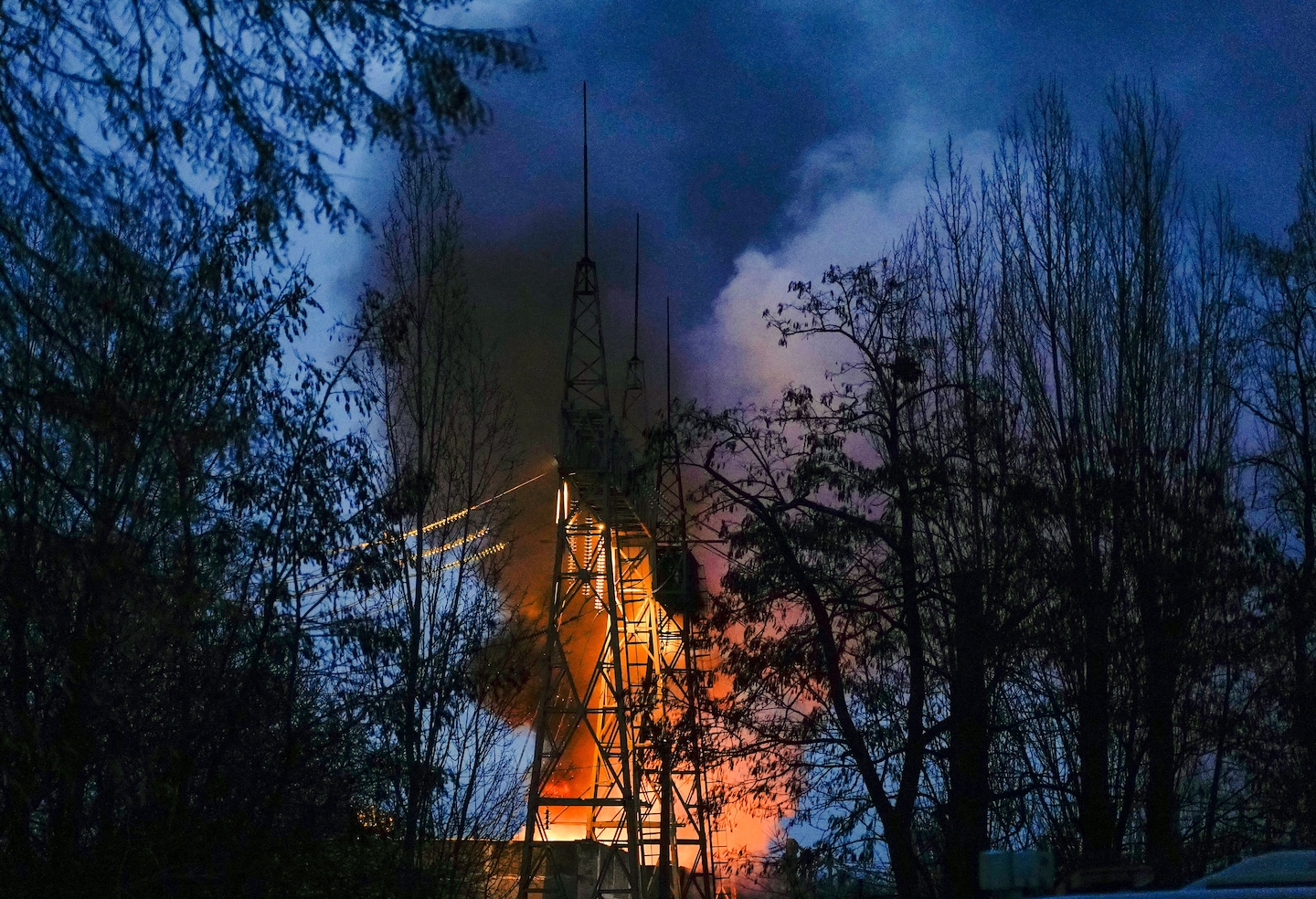Air raid sirens rang out in Kyiv at 2 a.m., the shrill sound amplified by the emptiness of the capital’s streets during its overnight curfew.
Russia has been bombing Ukrainian cities relentlessly with missiles and drones since early October, seeking to destroy the country’s energy grid and leave citizens without urgent services in the frigid winter, including a heavy missile barrage on Friday.
But Monday’s strikes mark the first time Russia had sent such a large fleet of drones overnight — potentially a recognition by Russian commanders that their noisy, slow-flying Iranian drones are far easier to spot and shoot down during daylight.
Ukraine’s Western supporters have rushed to bolster its air defenses in response to the repeated Russian missile and drone strikes. But while the Ukrainian military claimed to have destroyed most of the unmanned aerial vehicles, or UAVs, officials said several had hit their targets, causing new and serious damage to the country’s energy systems.
“All night, enemy UAVs tried to break into energy facilities throughout the country,” Ukraine’s main power grid operator, Ukrenergo, said in a statement. “Thanks to the professional work of the Air Defense Forces, the enemy did not fully achieve its goal, but, unfortunately, there are several hits on infrastructure facilities.”
“Currently, the most difficult situation has developed in the central, eastern and Dnipro regions,” the company’s statement continued. “Schedules of emergency shutdowns have been introduced in Sumy, Kharkiv, Poltava, Dnipropetrovsk, Zaporizhzhia, Kirovohrad, Zhytomyr, Chernihiv, Cherkasy, Kyiv regions and the city of Kyiv. Critical infrastructure facilities are prioritized. Restoration of energy supply to household consumers may take a long time.”
Ukrainian air force officials said in a statement that the country’s air defense systems shot down 30 out of “around 35” Iranian-made Shahed drones, which it said were launched from the “eastern coast of the Azov Sea.”
“Units of antiaircraft missile forces, fighter aircraft and mobile fire groups [were] involved in the destruction of the aerial targets,” according to the air force statement, posted on its Telegram channel.
The Washington Post could not independently confirm the air force’s figures.
But the scale of the overnight attack nonetheless confirmed that Russian President Vladimir Putin has no intention of scaling back his bombardment of Ukraine’s infrastructure systems, which international experts say has pushed the country to the brink of a humanitarian crisis and could trigger a second wave of millions of Ukrainian refugees to neighboring countries should life in winter become unbearable.
“Russian missiles and Iranian drones are constantly used to strike primarily at our energy sector,” Ukrainian President Volodymyr Zelensky said, adding that Friday’s attack alone had left the vast majority of Ukraine without electricity.
“On the evening of December 16, 22,408,000 Ukrainians were disconnected from the energy supply,” Zelensky said.
Dnipropetrovsk Governor Valentyn Reznichenko said on his Telegram channel that Russian forces on Monday had attacked his southeastern region with “drones, heavy artillery and Grad rockets.” Hanna Zamazeeva, the head of the regional council in the southern Mykolaiv region, said that Ukrainian air defense forces “shot down 10 Iranian-made Shaheed-136 drones.”
Monday’s attacks occurred hours before Putin arrived in Minsk for talks with his Belarusian counterpart, Alexander Lukashenko.
The visit is being closely watched for indications of a possible impending assault to be launched from Belarusian territory, just as Russia initiated its assault on Kyiv from there last winter.
Ukrainian authorities have warned that such an attack could take place as soon as the end of January, though U.S. defense officials have said they see no sign of such an assault in the near future.
Russia has previously targeted Ukrainian with drone strikes, most recently in the southern port city of Odessa.
But Monday’s assault was the largest so far against Kyiv, Deputy Mayor Andriy Kryshchenko said. In previous attacks, the drones had been accompanied by missiles.
“It’s a change in tactics — they’re trying to find the weak spots,” Kryshchenko said by telephone from the front lines in the east where he is currently serving. “They are trying somehow to alter the picture, they are trying a new approach.”
It is unclear how long Russia can sustain its air assaults.
Secretary of Ukraine’s National Security and Defense Council Oleksiy Danilov told local media that Ukrainian intelligence indicates Russian forces are reaching the end of their missile stocks, and have the capacity left for “two-three, maximum four” major attacks involving dozens of missiles, such as Friday’s attack in which more than 70 were fired.
However, Russia still has sufficient numbers of S-300 missiles — an older, less accurate weapon — Danilov said.
Danilov told The Washington Post that as a result of its diminishing stocks, Russia is now asking Iran for more missiles. “If Iran will provide them with rockets, this will be a challenge for us, this will be a very big danger,” he said.
The head of the Kyiv City Military Administration, Serhiy Popko said that Kyiv had faced “several waves of attacks of Iranian drones” during the early morning hours. In total, 23 drones entered Kyiv’s airspace, of which 18 were shot down, Popko said, according to the military administration’s Telegram channel.
City authorities said a “object of critical infrastructure” was damaged.
Ukraine’s emergency services posted photos and video of a fire at what appeared to be an electrical substation. Substations have been a main target of Russia’s airstrikes, because knocking them out can paralyze power transmission. The emergency services said the fire burned for more than two hours.
Kyiv’s regional governor, Oleksiy Kuleba, said on a television that the drone attack was “sufficiently serious.” Three people were injured and nine homes were damaged, in addition to the strikes on infrastructure, Kuleba said. Kyiv city officials said that two residential areas were hit by falling debris of damaged drones but that no one was injured.



